2025 Solar Ultrasonic Animal Repeller with Motion Detection and LED Strobe
$38.99
Tired of night raids and messy beds? This 2025 Solar Ultrasonic Animal Repeller, 2-pack uses a PIR motion sensor to spot warm-bodied movement and instantly fires a burst of ultrasonic sound with a bright LED strobe, nudging cats, deer, raccoons, squirrels and rabbits to move along. It is humane, weather-ready and designed to work best at entry paths where surprise matters, not constant noise.
Description
If stray cats are digging up seedlings, deer are sampling your beds at dawn, or squirrels and raccoons keep treating your yard like a buffet, this 2-pack 2025 Solar Ultrasonic Animal Repeller with Motion Detection and LED Strobe gives you a quiet, hands-off way to push wildlife back to the edges of your property. Each unit uses a PIR motion sensor to detect warm-bodied movement, then fires a burst of ultrasonic sound paired with a flashing LED strobe to startle animals and break their pattern of visits.
I am upfront about results for these tools. Independent wildlife and extension sources note that sonics and ultrasonics can be part of a broader deterrent strategy, and motion-activated lights and sound are more effective than constant noises because they reduce the chance animals get used to them. That is exactly how this repeller operates. It only activates when something moves in front of it, combining sound with a strobe to create a brief surprise that encourages deer and small mammals to move along.
Key Customer Benefits
- Humane, non-toxic wildlife control: Scare-and-go deterrence lets you protect beds and pens without poisons or traps. Extension guidance consistently recommends non-lethal tools like frightening devices and repellents as first-line tactics for home landscapes.
- Motion-activated surprise that reduces background noise: The PIR sensor only fires when an animal enters the zone, delivering a brief burst of ultrasonic sound with a flashing strobe. Research on light-and-sound scare devices for deer and carnivores shows they can be effective around focused attractants, especially when activation is event-based rather than constant.
- Better at night raids: Nocturnal visitors like raccoons often test gardens after dark. A sudden flash can be more startling in low light, and municipal and extension guidance notes lights and audible cues as practical deterrents for deer and small mammals.
- Solar convenience with two units to cover entries: Solar power keeps maintenance simple and a 2-pack lets you bracket common approach paths. Many units in this category use a wide detection arc and a typical trigger distance measured in tens of feet, so you can position one by the garden edge and another near compost or feed storage.
- Plays nicely with an integrated strategy: Wildlife specialists stress that no single tool is perfect. Pairing a solar ultrasonic animal repeller with simple fixes like moving attractants, tidying feed, or adding a temporary barrier improves results and slows animal learning.
- Mindful of people and pets: The goal is to nudge wildlife away without harming them. That said, a minority of people and small pets can perceive certain high-pitched tones, so placing devices to face outward and away from living areas is a smart best practice.
Product Description
What this 2-pack repeller is
The 2025 Solar Ultrasonic Animal Repeller with Motion Detection and LED Strobe is a pair of weather-ready, solar-charged units that you place where animals typically enter or feed. When the built-in motion sensor notices a warm-bodied visitor, each unit quickly responds with a short burst of high-pitched sound and a bright, blinking strobe. That quick surprise is what sends deer, cats, raccoons, squirrels and rabbits looking elsewhere, while you protect beds, bins and feed without traps or poisons. Devices that combine sound with flashing light are widely used in gardens and around small livestock because the stimulus is brief, startling and tied to the animal’s movement rather than running constantly.
How it works under the hood
At the heart of each device is a PIR motion sensor. PIR means passive infrared, and it detects movement by noticing tiny changes in heat against the background, which is exactly what a warm animal creates as it crosses the sensor’s field. Once triggered, the electronics drive a speaker to emit ultrasonic tones that most humans do not notice, and the LED array fires rapid flashes that are especially conspicuous at night. Because the unit uses solar charging, you avoid frequent battery swaps and can set it at trail height or fence height where the sensor sees approaching animals clearly.
Why this approach can be effective
There is no single solution for wildlife. Still, there is credible evidence that event-based light and sound can reduce intrusions when positioned at likely entry points and used as part of an integrated plan. A peer-reviewed study on red deer found that a combined portable light and ultrasound deterrent cut use of protected areas by about forty nine percent on average, and by roughly sixty seven percent when animals attempted to cross a line of devices.
A separate RSPB-supported trial on ultrasonic cat deterrents documented a meaningful drop in cat incursions into gardens, enough for the charity to recommend a tested device for sensitive areas. Studies on motion-activated frightening devices for deer and elk also show measurable reductions in feeding and crossings during active periods. These results align with field guidance that intermittent, motion-triggered stimuli reduce the chance that wildlife becomes comfortable with the cue.
Just as useful are practical lessons from homeowners. Users report that animals tend to shift their paths after a few nights, especially when the strobe is aimed along a trail or at a known attractant like a compost heap. Some neighbors can hear certain high-frequency tones, so thoughtful placement facing outward from patios and windows is smart. These on-the-ground details matter, and they help you get the most out of a simple tool.
What makes this pair different in daily use
Two units let you do something important. You can bracket an approach, such as the gap between hedges and the corner of a shed, or you can layer protection by aiming one at the feeder area and another at the compost pile. That flexibility is often the difference between animals skirting one device and animals deciding the whole space is uncomfortable. The motion-activated format also respects extension advice that frightening devices work best when they do not drone on in the background. Instead, they deliver a short, memorable surprise only when an animal is present.
Product Specifications
| Feature | What to expect in this 2-pack class |
|---|---|
| Detection method | PIR motion sensor that reacts to warm-bodied movement. Typical detection angle around 110 to 130 degrees, with a trigger distance about 8 to 10 meters which is roughly 26 to 33 feet. |
| Deterrents | Ultrasonic tones plus flashing LED strobe. Many models also offer an optional audible alarm mode. Frequency settings are typically multi-mode between about 13.5 to 23.5 kilohertz, with a dedicated strobe-only mode. |
| Power and charging | Built-in solar panel for daytime charging, plus USB backup in the box for first charge or long cloudy spells. Internal pack is commonly rechargeable AA Ni-MH or a single-cell lithium around 600 to 2000 mAh, depending on model. |
| Weather protection | Outdoor-rated housings, typically IP44 to IP65 water ingress protection, with ABS plastic shells. |
| Coverage footprint | Think in terms of the sensor cone, not a perfect circle. With a 110 to 130 degrees cone and 8 to 10 m reach, a single head covers roughly a fan-shaped wedge in front of the unit. Some tested cat-specific units cite about 115 to 125 square meters in open, line-of-sight conditions. |
| Mounting options | Ground stake for quick installs, plus keyhole or holes for wall or fence mounting. Many packs include the stake, USB cable and manual. |
| Typical unit size | Panel areas around 11 x 8 cm are common, with stake lengths near 24 cm, though dimensions vary by brand. |
| Operating guidance | Select the frequency band for your target species. Manuals commonly map bands to animal groups, for example: Band 1 around 13.5 to 17.5 kHz for small rodents and skunks, Band 2 around 15.5 to 19.5 kHz for dogs, foxes, raccoons and deer, Band 3 around 19.5 to 23.5 kHz for cats, birds and smaller animals, and a Flash-only mode. |
| Safety notes | Ultrasonic frequencies sit above most adult human hearing and are non-injurious, but a small share of people and some pets may notice certain tones. Aim the speaker away from patios, windows and neighboring yards. |
How to Use and Install
1) Plan your “choke points” before you install
Walk the property at dawn or dusk and look for tracks, droppings, flattened grass, gaps under fences, or scuff marks on boards. Those tell you where animals enter. Place each head so it faces outward toward the approach, not back into the area you want to protect. Frightening devices work best when they surprise animals as they arrive, not after they are already feeding. Extension guidance on deer control calls out motion-activated lights, sound and sprinklers as useful short-term deterrents around those entry points.
2) Fully charge before first use
Out of the box, give each unit a full charge so it triggers at full power. Most manufacturer manuals in this category instruct you to charge by sun for about 12 hours or by USB for about 6 hours before installation. Several manuals also note that USB top-ups are smart after long cloudy spells.
Tip from the bench: if your unit uses replaceable AA Ni-MH cells, cycling a few full charges can restore capacity after storage, a note you will see in some manuals.
3) Mounting height, aim and angle
Set the PIR sensor roughly at animal chest height and aim across the likely path, not straight down a trail. PIR sensors detect lateral movement more reliably and can false trigger if pointed into direct sun or reflective water. For yard security lights, many installers use 6 to 10 feet as a practical sensor height. For wildlife, I usually start lower so the cone intersects the trail. Avoid aiming directly at patios or neighbor windows to reduce audible perception for people and pets.
Quick checks after mounting:
- Walk test from the sides and straight on to see where the LED strobe fires.
- If the unit has a sensitivity dial, start mid-range and adjust to cover the path without triggering on shrubs. Manuals typically provide a sensitivity or “radius” control for this purpose.
4) Set the mode for your target animal
Many solar ultrasonic repellers offer banded frequency settings for species groups and a flash-only or flash plus alarm mode. As examples from mainstream manuals:
- Lower bands around 13.5 to 17.5 kilohertz for skunks, small rodents and some canids.
- Mid bands around 15.5 to 19.5 kilohertz for dogs, foxes, raccoons and deer.
- Higher bands around 19.5 to 23.5 kilohertz for cats and birds.
- A combined sweep with LED strobe when you need maximum “startle.”
Expect to experiment the first week. If cats ignore a lower band, bump one notch up. If neighbors notice a tone, try flash-only at night.
There is published evidence that ultrasonic deterrents can cut cat incursions and shorten visit times, which is why I keep them for beds where fouling is a problem. The peer-reviewed CatWatch trial documented a moderate deterrent effect in gardens.
5) Position the solar panel for steady charging
Small panels on garden devices still follow the same principles as rooftop arrays. In the northern hemisphere, face panels toward true south and keep a modest tilt so rain sheds dust. Industry guides and DOE-summarized advice place a broad “good zone” for tilt between about 15 and 40 degrees. Clear vines or shrubs that cast shade during midday.
6) Keep panels clean and test monthly
Dust, pollen and bird droppings reduce charge and shorten nightly runtime. Wipe panels every month or two with a soft cloth and plain water or mild soap, then rinse. Avoid harsh chemicals or abrasive pads. Clean in the cool of the day to avoid thermal shock. Several homeowner and government guides echo this simple maintenance routine.
7) Use two heads to “bracket” an approach
With this 2-pack, aim one unit along the trail and the second across the likely feeding area. That creates overlapping cones so an animal crossing the first cone gets the surprise and then sees the strobe again near the attractant. Extension and practitioner advice on frightening devices is consistent. They work best when moved, rotated or re-aimed periodically so animals do not get comfortable. Set a reminder to nudge positions every one or two weeks.
8) Integrate with simple fixes for stronger results
No repeller stops every animal on its own. Combine the device with:
- Remove attractants near the protected area. Secure trash, pet food, fallen fruit and compost lids.
- Taste repellents for deer pressure on shrubs. Independent testing often favors active ingredients like egg solids or capsaicin for browse reduction.
- Physical help at the worst hot spots, such as low garden netting, a temporary fence panel or a gate latch. These layers slow learning and keep animals from being rewarded.
Frequently Asked Questions
Do ultrasonic animal repellents actually work, or is this wishful thinking?
Short answer. They can help, especially when motion-triggered and combined with other fixes, but they are not magic. A peer-reviewed field trial funded by the RSPB found a moderate reduction in cat intrusions in gardens that used an ultrasonic unit, which is why the charity endorses a tested model. Broader wildlife research agrees that frightening devices are most useful when stimulus is brief and unpredictable, not constant. Some reviews are skeptical for certain pests, so the realistic play is to treat sonics and strobes as one tool in a small toolkit. Seal attractants, rotate positions, and change modes to slow animal learning.
Will raccoons, deer, or squirrels just get used to it after a while?
Animals learn quickly, particularly raccoons and deer. Studies of light-and-sound deterrents show meaningful reductions in crossings at first, and then a habituation effect if the setup never changes. Rotate the devices every week or two, vary the frequency band, and aim at the approach rather than the food source so the surprise happens before they get rewarded. Consider adding a taste repellent on key plants or a simple barrier where pressure is heaviest.
Can people or pets hear these things, and is there a safety concern?
Most adults do not hear the higher ultrasonic bands, yet a small number of people and some pets can perceive certain tones. That shows up often in neighbor forums where folks describe a faint whistle. The devices are designed as non-injurious deterrents, however comfort matters. Aim the speaker away from patios, windows, and neighboring yards, and use higher bands or flash-only at night if someone is sensitive.
I tried one for raccoons. It helped for a week, then they were back. What am I doing wrong?
You are not alone. Real-world users report exactly that pattern. The fix is to change several variables at once. Re-aim across the path, move the unit a few feet, increase sensitivity just enough to catch lateral movement, and add a motion-light layer or secure trash and pet food. Wildlife pros regularly recommend motion-activated light as a cost-effective add-on for raccoons because the sudden flash in darkness boosts the startle effect.
Where should I mount it to cut down false alarms from sun or moving leaves?
PIR sensors notice changes in heat. Direct sunrise, reflective water, hot air vents, or waving warm foliage can trigger them. Aim slightly across an approach rather than into morning sun, keep reflective surfaces out of the cone, and trim vegetation that moves in the sensing zone. If your unit has a sensitivity dial, start at medium and adjust until it catches you on a walk-test but not every leaf flicker.
What do the IP ratings on the box mean for rain and weather?
IP is a standardized way to describe dust and water ingress protection. You will often see IP44 on lighter garden gear which means splash resistant in sheltered spots, and IP65 on more robust housings which are dust tight and resist low pressure water jets from any direction. For devices that live out in the weather, IP65 gives you better margin in storms.
How big an area does one unit cover in real life?
Think in cones, not circles. A typical garden repeller lists a detection angle around one hundred and ten to one hundred and thirty degrees and a trigger distance around eight to ten meters in open view. Shrubs, slopes, and height change those numbers. Use the two-pack to bracket entries. One looks along the trail and the other watches the target bed, so an animal meets the surprise twice on a single approach.
Do ultrasonic repellents bother birds or help keep them off fruit?
Evidence for bird control via ultrasonics is weak. A classic review of frightening devices concluded that ultrasonic devices are generally ineffective on birds, which hear different frequency ranges. For ripening fruit, lean on netting and brief acoustic or visual scares that you rotate, rather than ultrasonics.
How often should I clean the solar panel, and how should I do it?
Dust and droppings cut charge. Plan a quick wipe every few months, or more often if you are in a dusty spot. Use a soft cloth with water, add a little mild detergent for sticky grime, rinse, and dry. Avoid harsh chemicals and do the cleaning in the cool of the day to reduce thermal stress on the glass. Guidance from residential solar maintainers and garden-light specialists aligns on these basics.
My neighbor can hear the unit and is upset. What is the courteous way to solve this?
Start by changing the band to a higher frequency, reduce sensitivity, and angle the speaker away from their side. If the device supports a flash-only mode at night, try that. Community threads show that a simple conversation plus small adjustments usually fix the issue. If you cannot reach agreement, consider moving the unit a few feet or using a different layer such as motion lighting or a low fence panel for that boundary.
Is there any proof that motion-activated lights actually help with night raids?
Yes. Wildlife control operators and city wildlife programs routinely recommend motion-sensed lighting for nocturnal species. Field write-ups note that the sudden illumination can send raccoons moving on, especially when you vary placement so the pattern is not predictable. Pairing a light with sonic and strobe cues gives you more tools to rotate.
Conclusion
You are not trying to fight nature. You are trying to set gentle boundaries so cats stop fouling beds, deer stop nibbling, and night raiders keep moving. The 2025 Solar Ultrasonic Animal Repeller with Motion Detection and LED Strobe fits that mindset. It is humane, it is simple to live with, and it gives you two smart tripwires you can place where animals actually enter. Field guidance backs the approach. Motion-triggered frightening devices can reduce intrusions when tied to entry points, especially as part of an integrated plan that removes easy food and rotates tactics so animals do not learn the pattern.
There is also real-world evidence for pieces of the toolkit you are using. A peer-reviewed garden trial documented a measurable reduction in cat visits with an ultrasonic deterrent. Wildlife operators and municipal resources routinely recommend motion-sensed lighting to surprise nocturnal species such as raccoons. Those two ideas are built into your repeller’s design, and you can layer a separate motion light if night raids persist.
Related products
-
Bonide Go Away! Rabbit, Dog, and Cat Repellent Granules, 3 lbs
$21.47 Buy Now -
Sale!
Safer Brand Critter Ridder Animal Repellent Granules, 2 lb, OMRI Listed
$19.99Original price was: $19.99.$9.88Current price is: $9.88. Buy Now -
Eco‑Solar Ultrasonic 3‑in‑1 Animal Repeller for Squirrels, Deer, Raccoons, Cats
$38.98 Buy Now -
Cat Repellent Outdoor 2 Pack, Solar Ultrasonic with PIR Motion Sensor
$45.99 Buy Now
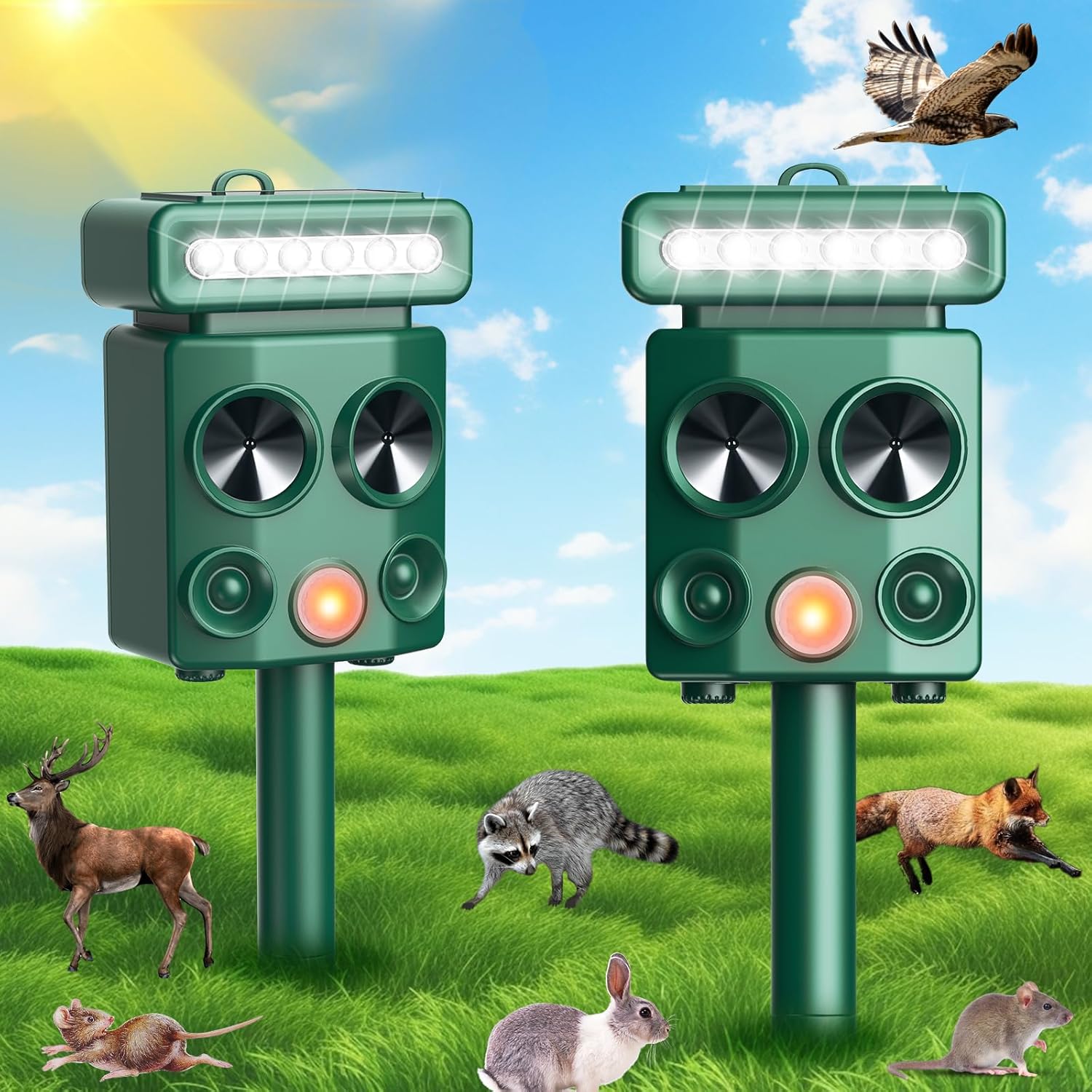
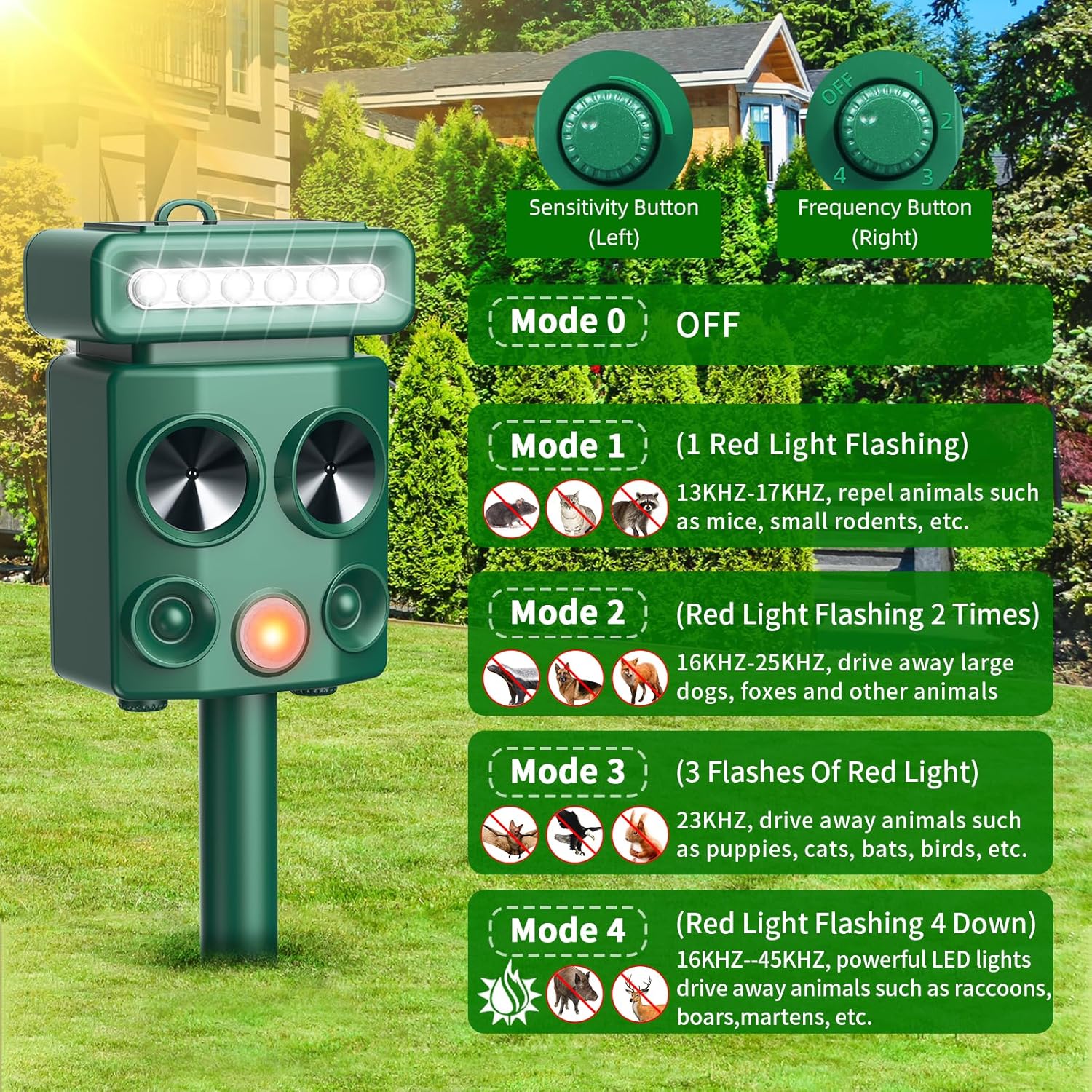
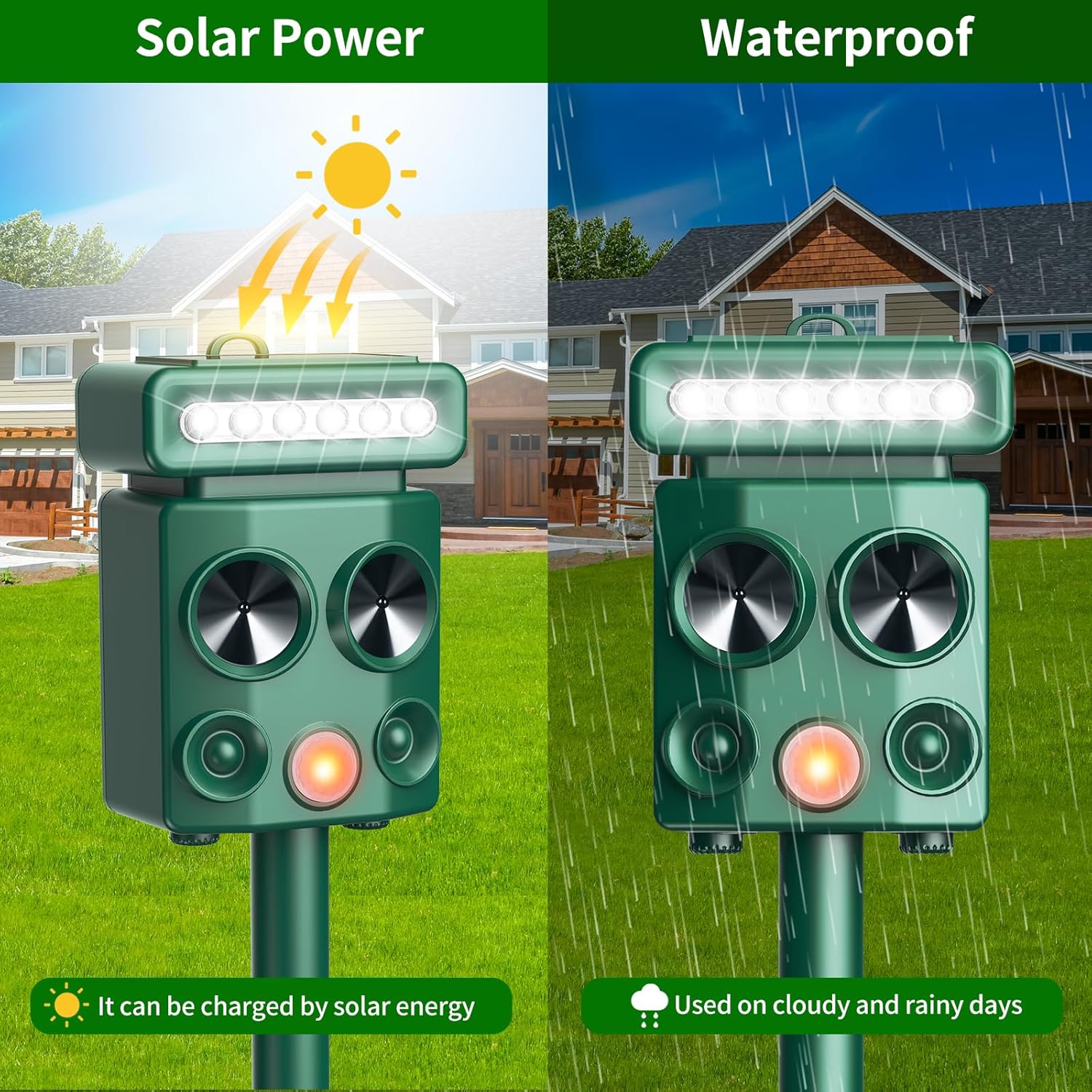
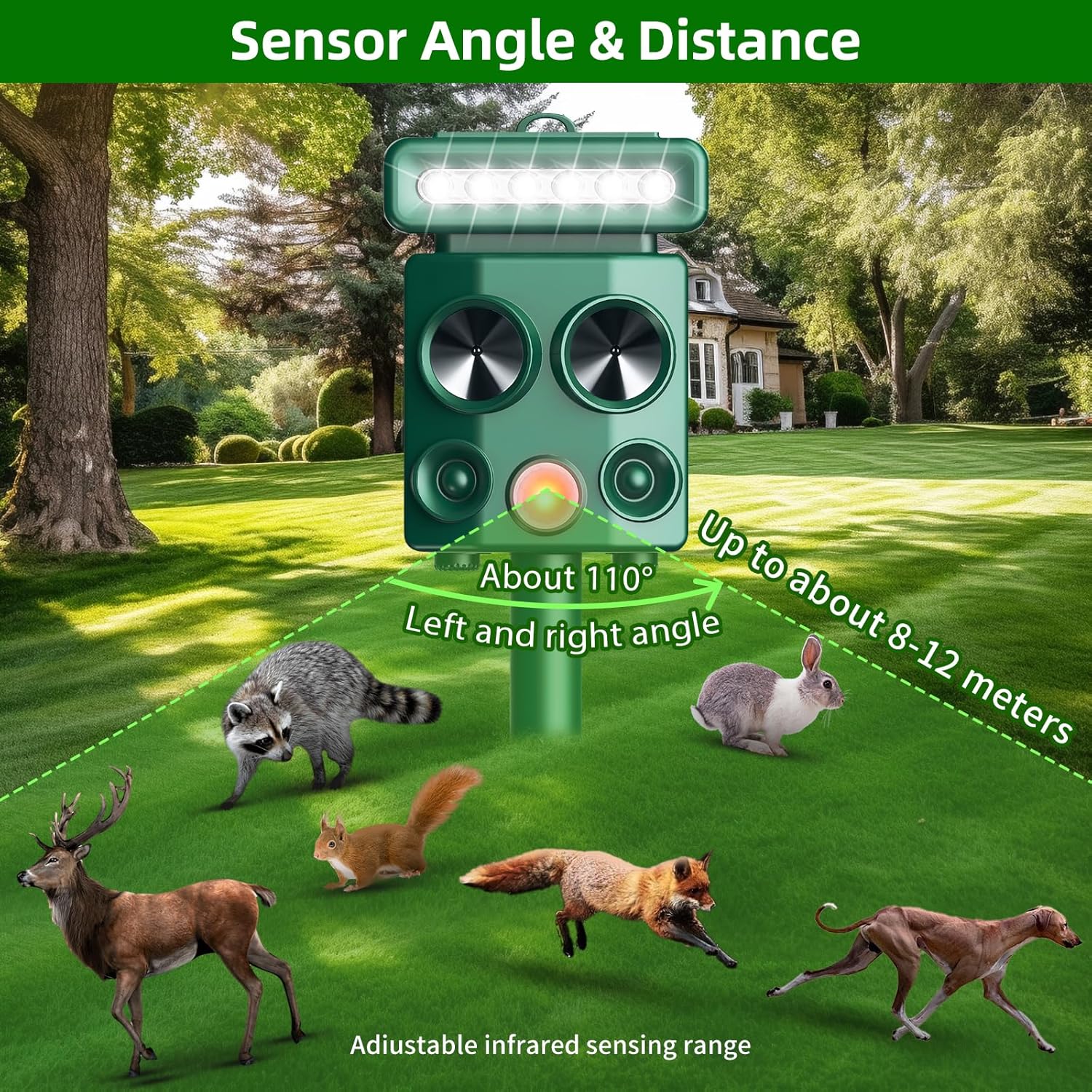
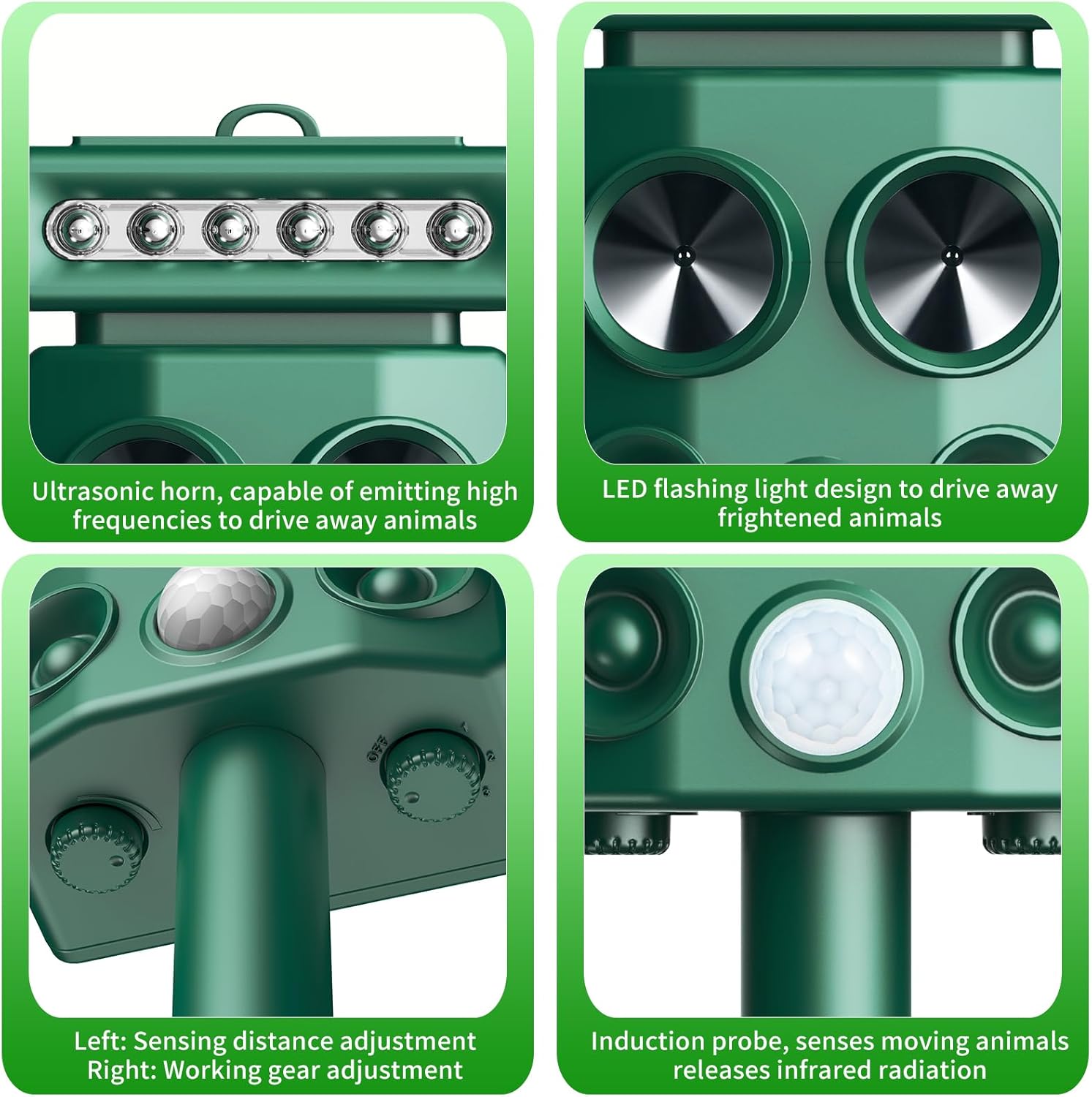
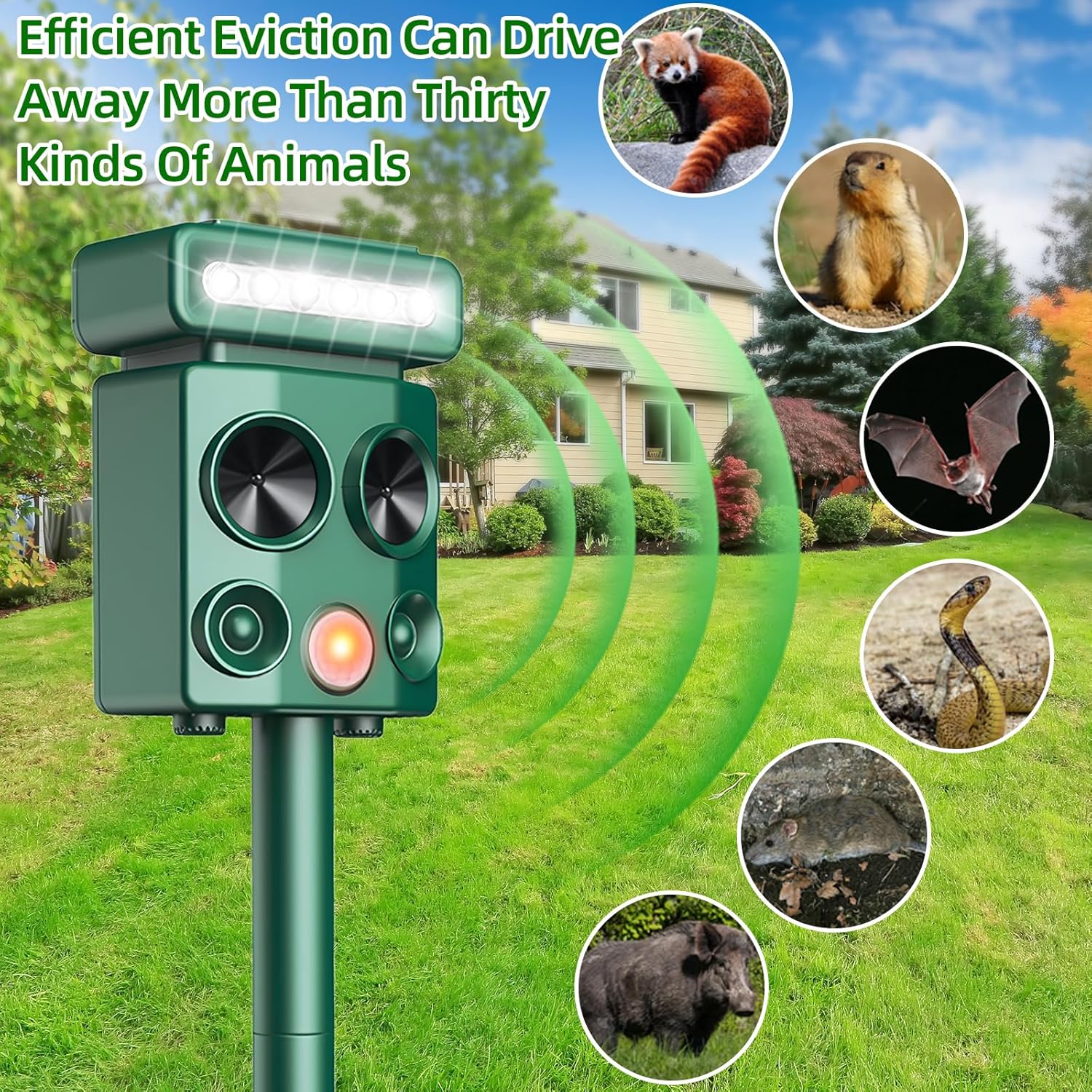
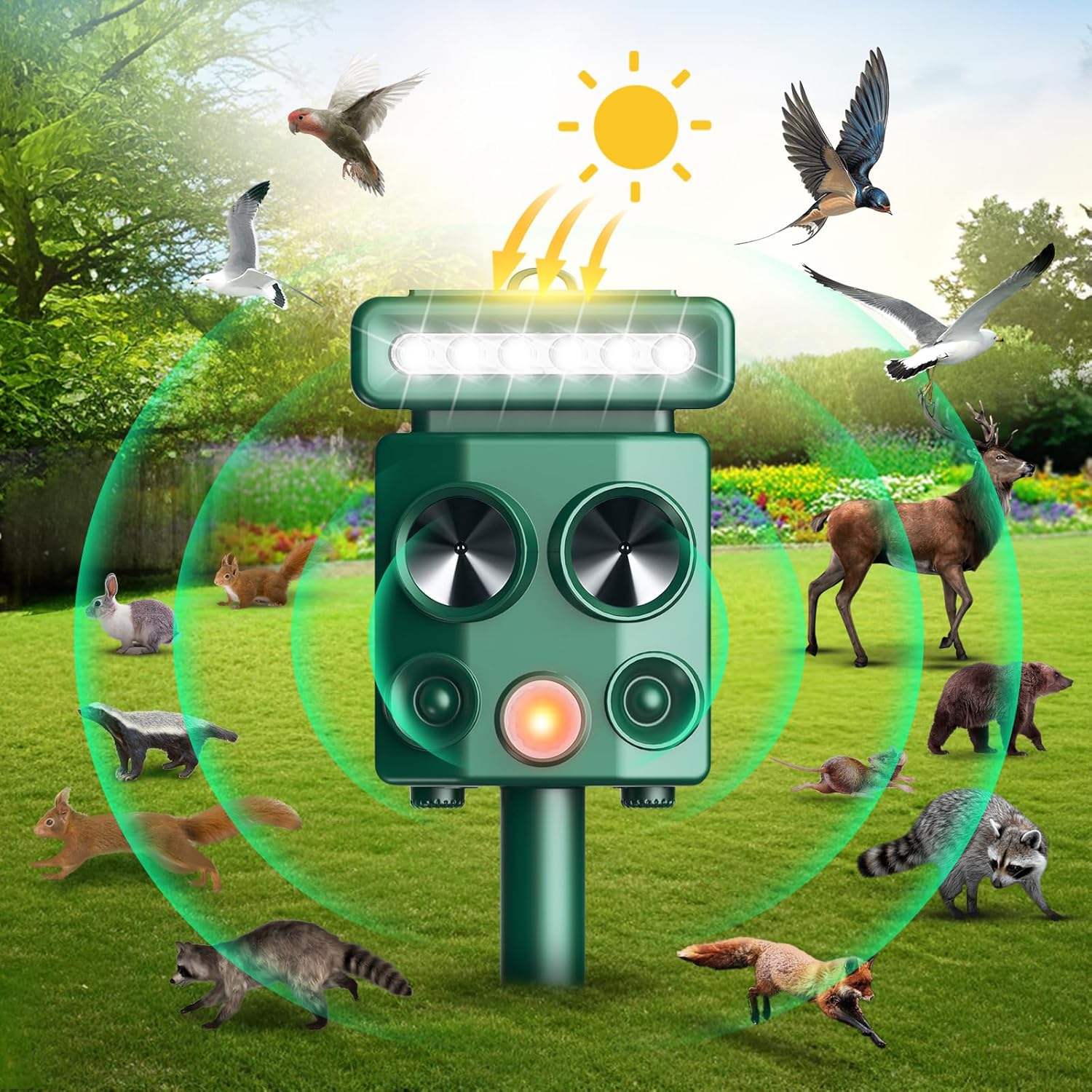

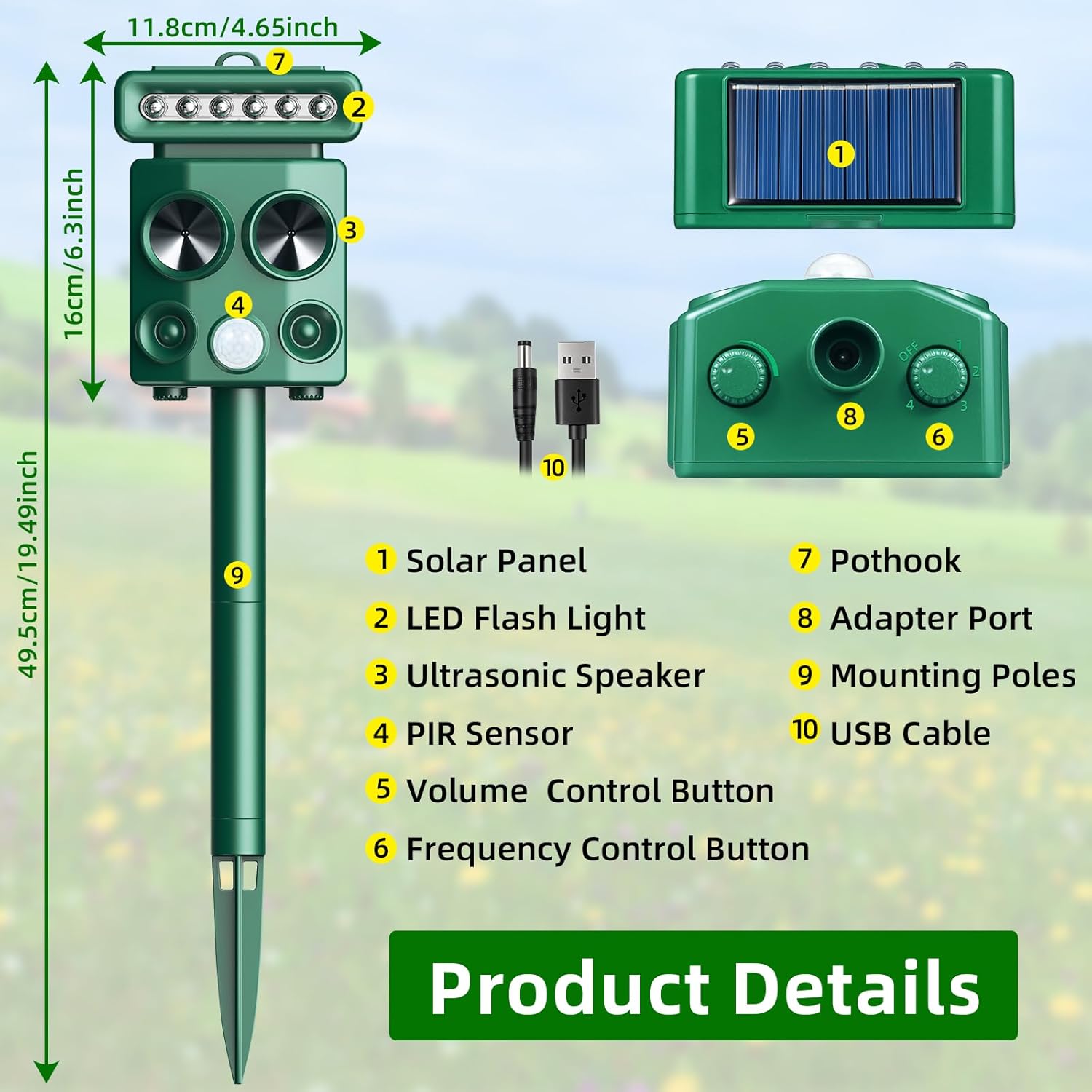
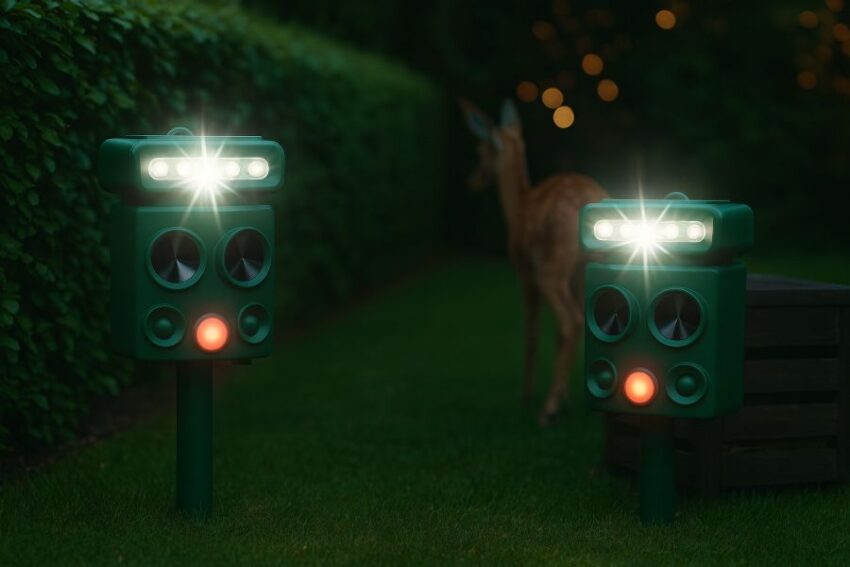
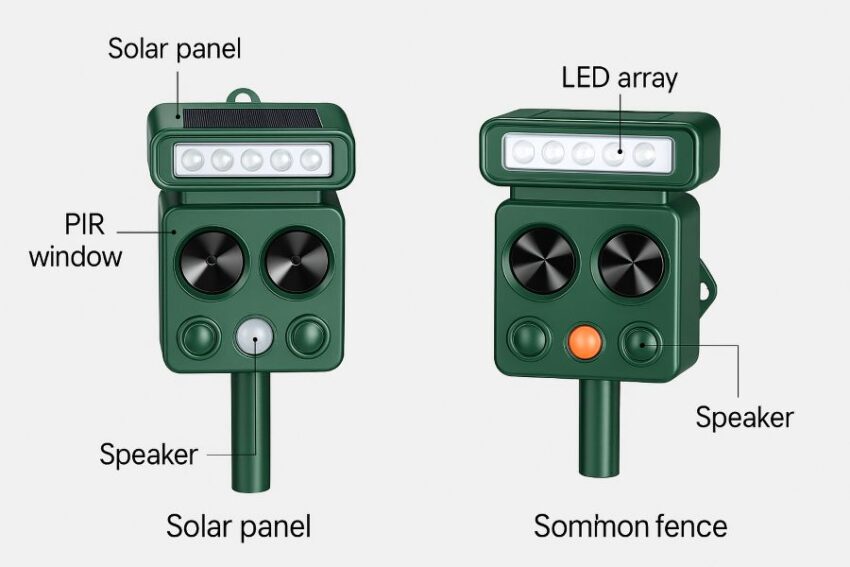
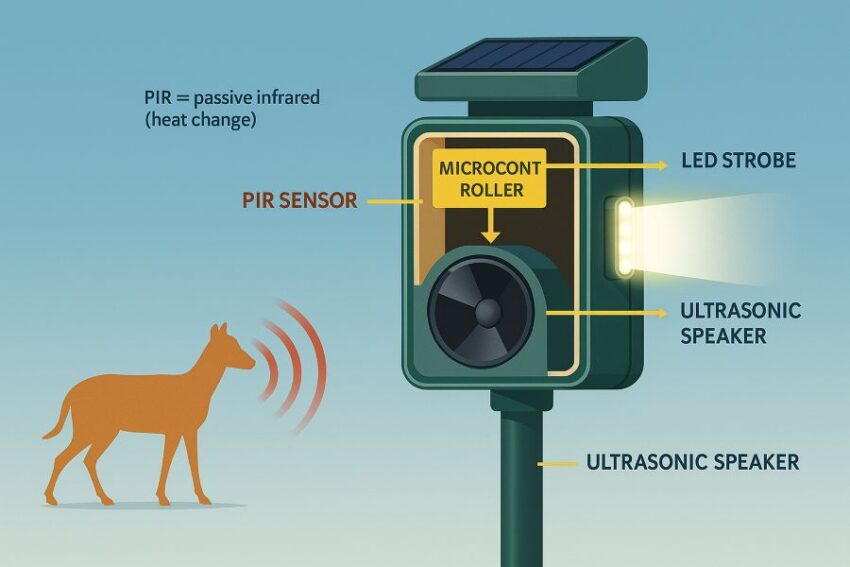
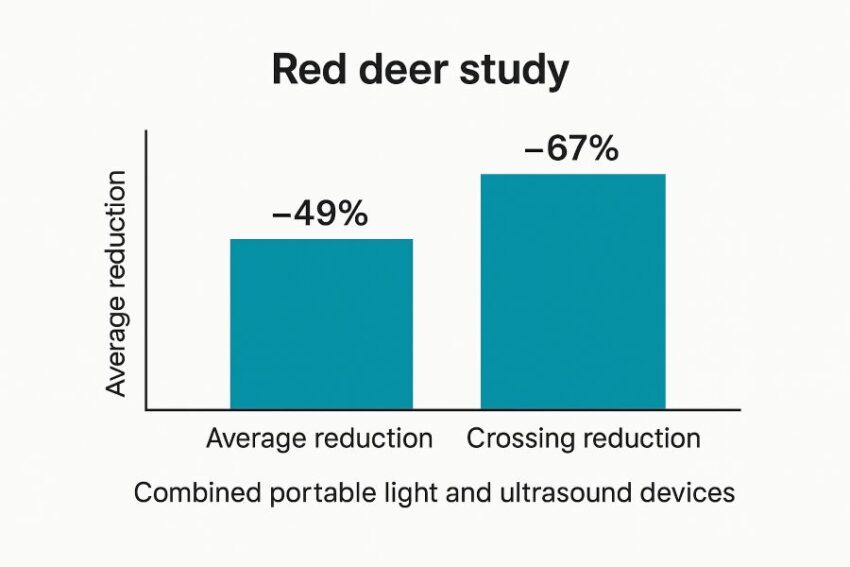
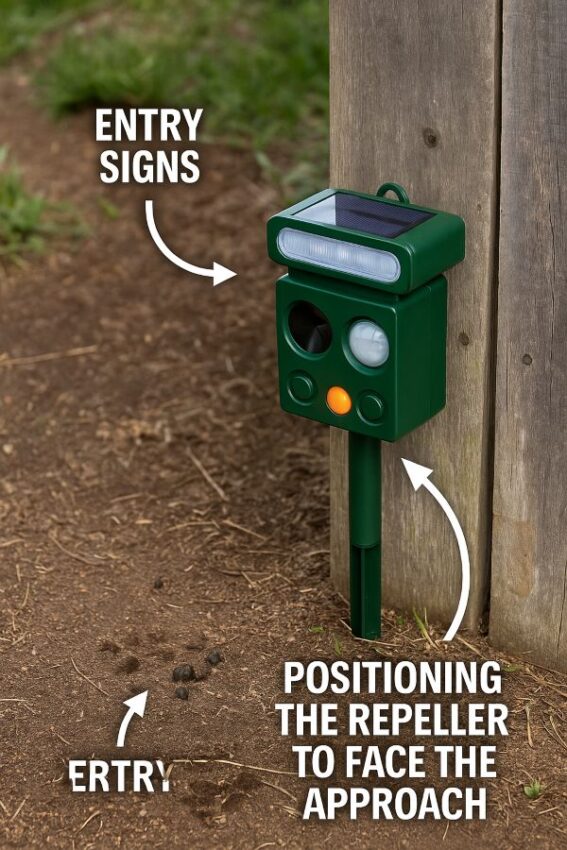
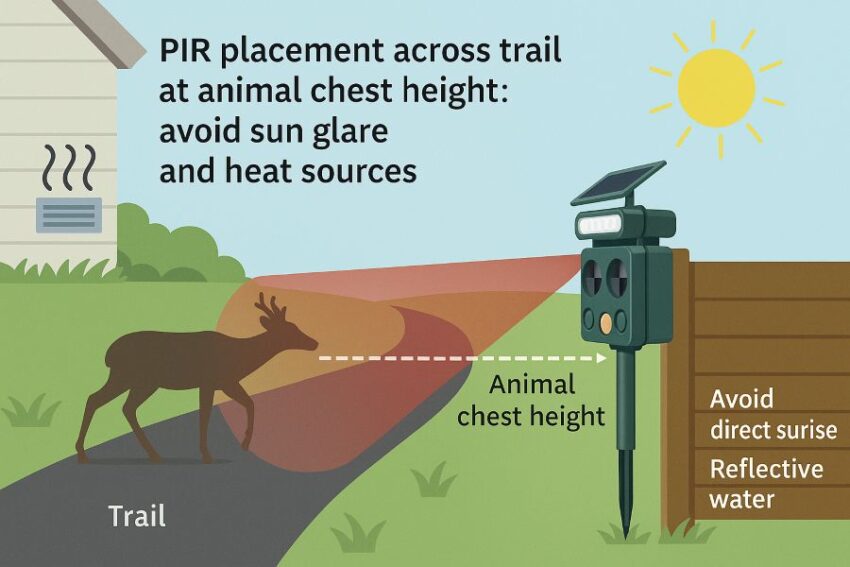
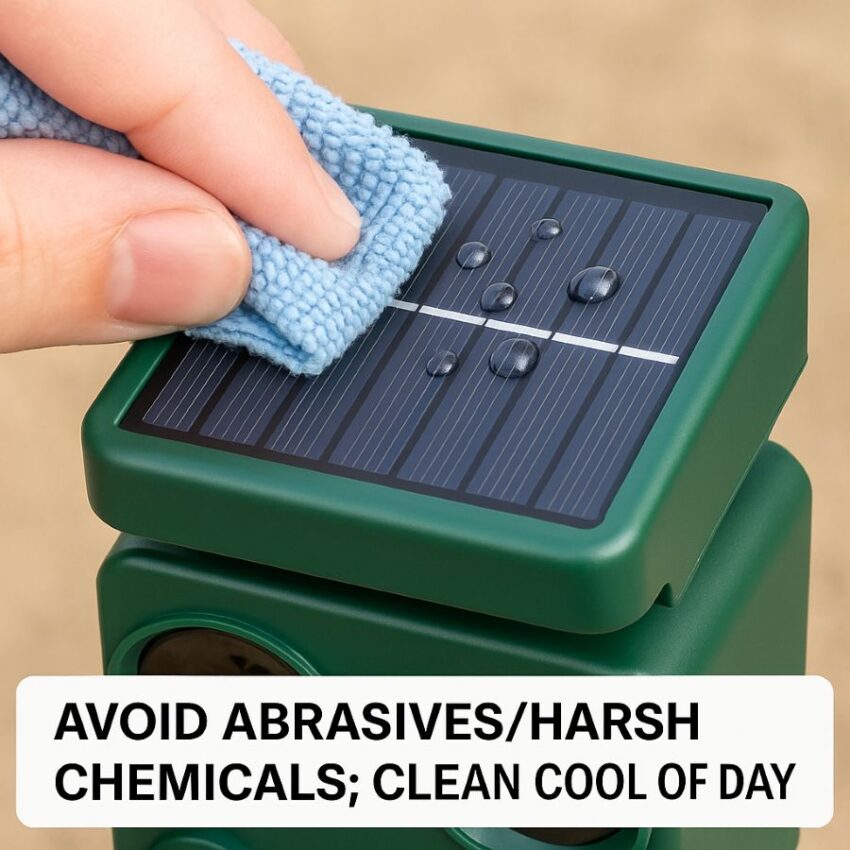



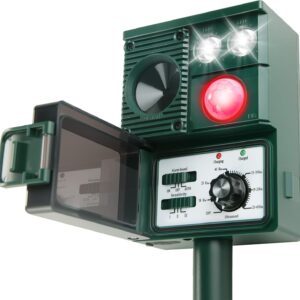
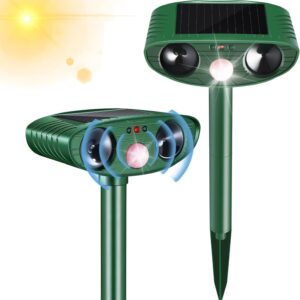
Reviews
There are no reviews yet.